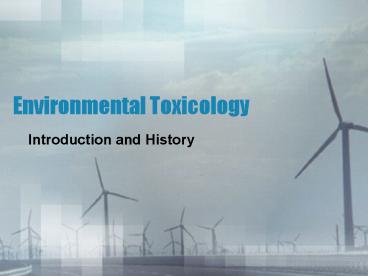Environmental Toxicology - PowerPoint PPT Presentation
1 / 18
Title:
Environmental Toxicology
Description:
Environmental Toxicology Introduction and History Course Objectives Elucidate basic principles of toxicology as they apply to both ecological and physiological ... – PowerPoint PPT presentation
Number of Views:1116
Avg rating:3.0/5.0
Title: Environmental Toxicology
1
Environmental Toxicology
- Introduction and History
2
Course Objectives
- Elucidate basic principles of toxicology as they
apply to both ecological and physiological
systems - Evaluate sources, effects, and fates of toxins in
individual components of ecosystems - Promote understanding of how toxic effects are
integrated within ecosystems and on a global
scale - Increase knowledge of current issues in
environmental toxicology
3
Why teach Environmental Toxicology?
- A relatively new science that grew out of two
phenomena - Dramatic presence of human species on the
landscape - Awareness of environmental degradation (either
real or potential) the importance of a healthy
environment in maintaining the quality of life
4
Increased Presence of Humans
5
Environmental degradation/improvement
1970 1986 2002
World popn (109) 3.7 5.3 6.2
World carbon emissions (109 T) 3.9 5.2 6.6
Solid waste in U.S. /year (106 t) 100 130 369
Land in urban develop. (106 ac) 35 47 63
U.S. ac. treated w/herbicides (106) 158 362 194
Coal use (106 t) 613 890 1065
Lead emissions (103 T) 204 21 6.2
Sulfur dioxide emissions (106 T) 27 21 10.2
Fish kills in US by pollution (106) 22 10 10
Accidental oil spilled at sea (103 T) 84 6 116
DDT in human adipose tissue (ppm) 8 2 0.03
6
Ecology vs Toxicology vs Environmental
Toxicology
- Definitions
- Ecology the study of the interactions among
organisms and between organisms and the
environment - Toxicology study of biological effects of
toxins - Environmental toxicology
- Truhart, 1969 - study of adverse effexcts of
chemicals and physical agents on living organisms - Duffus, 1980 study of effects of toxic
substances in both natural and human-created
environments - Moriarity, 1985 study of the fate and effects
of toxic compounds on ecosystems - Calow, 1993 protection of ecological systems
from adverse effects by synthetic chemicals - Landis and Yu - ?
7
Environmental toxicology an interdisciplinary
science
- Encompasses multiple disciplines
- Ecologists
- Chemists
- Molecular biologists
- Geneticists
- Pharmacologists
- Mathematical modelers and statisticians
- Happens because fundamental interaction of
toxicants is at the molecular level but effects
occur across multiple biological and physical
scales (see Fig. 1.1)
8
Difference between Toxicology and Environmental
Toxicology
Classical toxicology Environmental
toxicology
Single organisms Organisms-populations-communities-ecosystems
Only direct effects measured Both direct and indirect effects measured
White rats/mice Daphnia (water flea), fathead minnow, midges, trout, Quail, Mallard duck, algae
Homogeneous populations under controlled laboratory conditions Natural populations in a variable environment
9
Variable Environments
- Water (1)
- called
- 2. Air environmental
- media
- 3. Soil
10
History of Environmental Toxicology
- A relatively new discipline
- 2006 30th annual symposium of the American
Society for Testing Materials (ASTM) and 27th
meeting of the Society of Environmental
Toxicologists and Chemists (SETAC) - Initial science directed at efficacy testing of
pesticides in 1940s? moved thru cleanup of
burning rivers, polluted lakes and wildlife kills
of 1960s ? environmental risk and life cycle
assessments of recently developed compounds
11
Main events fostering change in public perception
and thus environmental regulations
- Silent Spring published
- Cuyahoga River catches fire
- NEPA (National Environmental Policy Act)
- Establishment of the EPA
12
Environmental Science is driven by protective
legislation
- Federal Food, Drug and Cosmetic Act
- Toxic Substances Control Act (TOSCA)
- Federal Insecticide, Fungicide and Rodenticide
Act (FIFRA) - Comprehensive Environmental Response,
Compensation, and Liability Act (CERCLA,
Superfund) - Clean Water Act (CWA) 1974
- Clean Air Act (CAA) last amended in 1990
- Note can often have overlap of regulations with
different standards Ex. EPA reg. for Hg in wild
fish is 10X less than that allowed by FDA in
supermarket fish
13
Areas interacting within environmental toxicology
- Scientific community (academia)
- Governmental agencies
- Industry
- General Public
14
Scientific community (academia)
- Intellectual and industrial force driving
environmental research - Mostly financed by governmental grants
- Dissemination of information by peer-reviewed
publication, symposia and conferences, workshops - Most work accomplished by graduate students
(Thank you, graduate students!)
15
Governmental agencies
- Includes federal, state, provincial (Canada!) and
municipal agencies - Mostly act as developers and enforcers of policy
- Prime examples - US EPA, AR DEQ, AR GF
- Also includes
- FWS
- ACE
- NMFS
- USCG
- Lots of jobs paying decent
16
Industry
- Generally includes businesses that mine,
manufacture, transport, or use chemicals - Most environmental regulations designed to
control above - Industry has to test for toxicity, determine
levels of chemicals, design treatment systems - Often use environmental consulting firms or
in-house environmental staff - Fewer jobs but they can often pay ridiculous
amounts of
17
General Public
- Per Landis includes NGOs
- Citizens groups
- Rotary, Kiwanis
- Unions
- Environmental advocacy groups
- Sierra Club
- Audubon Society
- World Wildlife Fund
- Defenders of the Environment
- Etc
- Primary avenues of action
- Informing laypersons
- Lobbying legislators
- ?
18
Midnight sunset over Alaskan fishing village
Photo by R. Grippo































